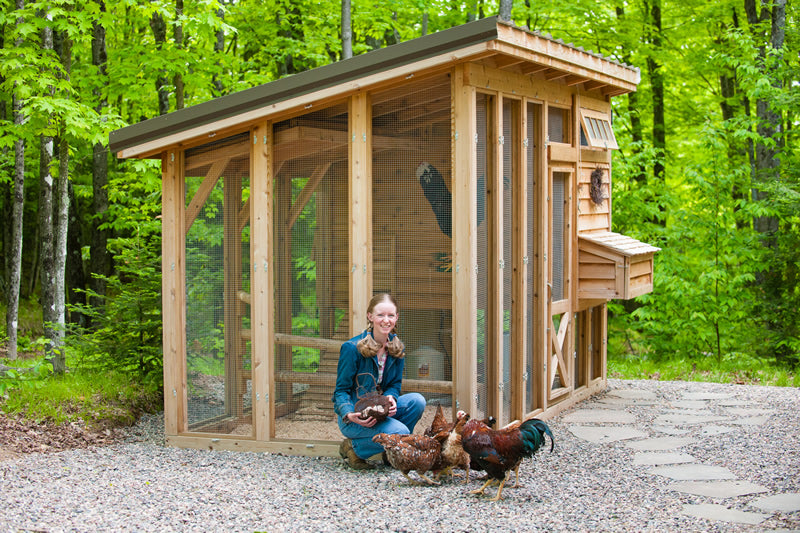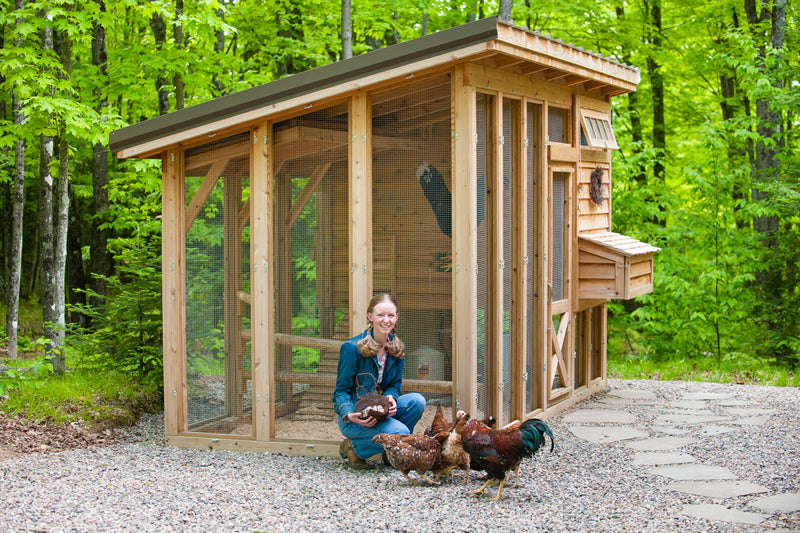
How to build your own chicken coop
Perhaps you're about to start raising chickens, and you've decided to save some money by building your chicken coop. Maybe you've had chickens in the past, but now you're ready to build the coop you've always wanted. Either way, you have great options! Check out these ideas and consider a few points while planning the coop of your dreams.

Decide on size
One of the first things you need to decide is what size your chicken coop will be. Bigger may be better, and of course the hens will love any extra space. Keep in mind that a bigger coop is more expensive, more time consuming to construct, and more square footage to clean. The size of your coop will depend on the number of chickens you would like to have in your flock, along with some extra room in case you decide to add more hens in the future. A starting guideline would be a minimum of three to four square feet of space per hen inside the coop.1
A coop with 16 square feet on the floor should be able to house four or five chickens. You might wish to consider giving your chickens more room if they will spend extra time in the coop due to inclement weather.
Include nest boxes
Remember that your coop will need a place for those hens to lay all their wonderful eggs. However, each hen doesn't necessarily need her own nest box. They'll be able to share, and you can probably supply one box for every three to four hens. Plan about one cubic foot (or perhaps a bit taller) of space for a good nest box. Bonus tip: consider a design that allows you to access the nest boxes from a door outside the coop. Then you don't have to go inside to collect the eggs!
Skip the chicken wire
Are you familiar with the woven, hexagonal fencing known as chicken wire? That type of fencing has its place, but it doesn't belong as a barrier to protect your chickens from predators. Chicken wire is light enough that predators like raccoons and foxes can break through it, so it's not suitable for the sides or doors of your coop. Instead, plan on using a sturdier type of wire for these purposes—something like ¼" or ½" hardware cloth. While more expensive, this type of material is far more appropriate for a chicken coop.2
But what about the chicken wire? It's better used to control chicken traffic from within the confines of a safer barrier. For instance, you might use chicken wire to section off a portion of the coop if you'd like to keep some chickens separated from the others (a hen that's ready to hatch her eggs, for example), or to control temporary grazing areas within a larger run.
Don't forget ventilation
Your chickens will need fresh air, and not just because it's pleasant and nice. Coops without proper ventilation may experience a buildup of unwanted gases like carbon dioxide or ammonia. The solution is proper ventilation. A good rule of thumb is about one-fifth of the coop's wall space or one square foot of ventilation per chicken. 3
You can achieve some ventilation through predator-safe windows that can be opened, but that may be too much ventilation in the winter. Gable vents (one on each end of the coop for cross-ventilation) are an excellent method of ventilating, as they allow the stale warm air (which will rise) to escape at the top of the coop.
Choose a location
Plan on building your coop far enough away from your home to prevent odor issues, but close enough to a water source to make daily chores simple and efficient. Also, consider local climate issues like shade and sun direction, prevailing winds, and ground quality (drainage, etc.).
Have fun with the design
Once you've considered all the practical aspects of coop building, have some fun with the design. What kind of siding should you use? Cedar shakes? Tongue-and-groove? Do you want to paint it a fun color that accents the décor of your property or stay with an all-natural wood look? How about the roof? Painted metal? Shingles? Something else? Use your imagination or find some inspiration and enjoy the process!
Take the next step
Try to narrow down a basic plan of what you'd like to build and get help with the construction if needed. And find out if a building permit is required in your area. Once your coop is finished, stock up on some chicken coop basics, like feeders, waterers, and safe electric lighting.
- Arcuri, Lauren. The Spruce. "Top 10 Tips for Building a Chicken Coop."https://www.thespruce.com/building-a-chicken-coop-3016589
- Mormino, Kathy Shea. The Chicken Chick. "Coop Security: Hardware Cloth vs. Chicken Wire." https://the-chicken-chick.com/coop-security-hardware-cloth-vs-chicken/
- Steele, Lisa. The Old Farmer's Almanac. "Chicken Coop Design Considerations." https://www.almanac.com/news/gardening/gardening-chickens/chicken-coop-design-considerations
